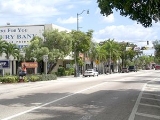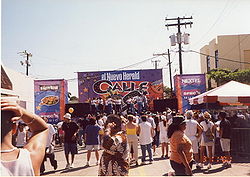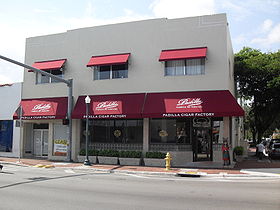
Little Havana
Encyclopedia

Florida
Florida is a state in the southeastern United States, located on the nation's Atlantic and Gulf coasts. It is bordered to the west by the Gulf of Mexico, to the north by Alabama and Georgia and to the east by the Atlantic Ocean. With a population of 18,801,310 as measured by the 2010 census, it...
, United States
United States
The United States of America is a federal constitutional republic comprising fifty states and a federal district...
. Home to many Cuba
Cuba
The Republic of Cuba is an island nation in the Caribbean. The nation of Cuba consists of the main island of Cuba, the Isla de la Juventud, and several archipelagos. Havana is the largest city in Cuba and the country's capital. Santiago de Cuba is the second largest city...
n immigrant
Immigration to the United States
Immigration to the United States has been a major source of population growth and cultural change throughout much of the history of the United States. The economic, social, and political aspects of immigration have caused controversy regarding ethnicity, economic benefits, jobs for non-immigrants,...
residents, Little Havana is named after Havana
Havana
Havana is the capital city, province, major port, and leading commercial centre of Cuba. The city proper has a population of 2.1 million inhabitants, and it spans a total of — making it the largest city in the Caribbean region, and the most populous...
, the capital and largest city in Cuba. The approximate boundaries are the Miami River
Miami River (Florida)
The Miami River is a river in the United States state of Florida that drains out of the Everglades and runs through the Downtown and the city of Miami. The long river flows from the terminus of the Miami Canal at Miami International Airport to Biscayne Bay...
(north), SW 16th Street (south), SR 9/West 27th Avenue (west) and I-95 (east). The neighborhood can also be said to extend as far west as LeJeune Road/West 42 Avenue. Little Havana is occasionally called the Latin Quarter.
Little Havana is noted as a center of social, cultural, and political activity in Miami. Its festivals, including Carnival Miami, Cultural Fridays, the Three Kings Parade and others, are televised to millions of people every year on different continents. It is also known for its landmarks, including Calle Ocho (SW 8th Street/Tamiami Trail
Tamiami Trail
The Tamiami Trail is the southernmost of U.S. Highway 41 from State Road 60 in Tampa to U.S. Route 1 in Miami. The road also has the hidden designation of State Road 90....
), and its Walkway of the Stars (for famous artists and Latin personalities, including Celia Cruz
Celia Cruz
Celia Cruz was a Cuban-American salsa singer, and was one of the most successful Salsa performers of the 20th century, having earned twenty-three gold albums...
, Willy Chirino
Willy Chirino
Willy Chirino, born April 5, 1947 in Consolación del Sur, Pinar del Río, Cuba, is an entertainer and singer in the salsa style.-Early Family Life:...
, and Gloria Estefan
Gloria Estefan
Gloria María Milagrosa Fajardo García de Estefan; known professionally as Gloria Estefan is a Cuban-born American singer, songwriter, and actress. Known as the "Queen Of Latin Pop", she is in the top 100 best selling music artists with over 100 million albums sold worldwide, 31.5 million of those...
), the Cuban Memorial Boulevard, Plaza de la Cubanidad, Domino Park, the Tower Theater, Jose Marti
José Martí
José Julián Martí Pérez was a Cuban national hero and an important figure in Latin American literature. In his short life he was a poet, an essayist, a journalist, a revolutionary philosopher, a translator, a professor, a publisher, and a political theorist. He was also a part of the Cuban...
Park, the Firestone/Walgreens Building, St. John Bosco Catholic Church, Municipio de Santiago de Cuba and others. It is undoubtedly the best known neighborhood for Cuban exiles in the world. Little Havana is characterized by a robust street life, excellent restaurants, cultural activities, mom and pop enterprises, political passion, and great warmth amongst its residents.
The Little Havana Merchants Association http://www.littlehavana.biz is an organization of local businesses that promotes responsible growth in the neighborhood. The group provides an online guide to local dining, shops, galleries, nightlife, and cultural events.
History
The name "Little Havana" emerged in the 1960s as the concentration of Cubans in the area grew sharply. Little Havana is the name affixed to a sprawling neighborhood lying immediately west of downtown Miami. It stretches west from the Miami River for several miles. This sobriquet was applied to the Shenandoah and Riverside neighborhoods in the 1960s, following the beginnings of a vast influx of Cuban refugees there. Little Havana is famous as the cultural and political capital of Cuban AmericanCuban American
A Cuban American is a United States citizen who traces his or her "national origin" to Cuba. Cuban Americans are also considered native born Americans with Cuban parents or Cuban-born persons who were raised and educated in US...
s, and the neighborhood is a center of the Cuban exile
Cuban exile
The term "Cuban exile" refers to the many Cubans who have sought alternative political or economic conditions outside the island, dating back to the Ten Years' War and the struggle for Cuban independence during the 19th century...
community
Community
The term community has two distinct meanings:*a group of interacting people, possibly living in close proximity, and often refers to a group that shares some common values, and is attributed with social cohesion within a shared geographical location, generally in social units larger than a household...
.
As of 2011, Little Havana has the highest concentration of Hispanics (98%) in Miami. Within the Hispanic population, the Cuban
Cuba
The Republic of Cuba is an island nation in the Caribbean. The nation of Cuba consists of the main island of Cuba, the Isla de la Juventud, and several archipelagos. Havana is the largest city in Cuba and the country's capital. Santiago de Cuba is the second largest city...
population has experienced a substantial decrease from 84% in 1979 to 58% in 1989; however, a group of Hispanics from other countries, especially the Nicaraguan population has substantially increased since the late-1990s.
Demographics
Demographically, the neighborhood is split up into Little Havana (proper) and West Flagler (formerly West Little Havana), and as of 2000, the total populationPopulation
A population is all the organisms that both belong to the same group or species and live in the same geographical area. The area that is used to define a sexual population is such that inter-breeding is possible between any pair within the area and more probable than cross-breeding with individuals...
of both of the sections made up 90,218.
As of 2000, Little Havana had a population of 49,206 residents, with 19,341 households, and 11,266 families residing in the neighborhood. The median household income
Median household income
The median household income is commonly used to generate data about geographic areas and divides households into two equal segments with the first half of households earning less than the median household income and the other half earning more...
was $15,213.16. The ethnic makeup of the neighborhood was 85.08% Hispanic or Latino of any race (mainly Cubans, but also many Nicaraguans and Hondurans), 3.79% Black or African American, 10.14% White, and 0.96% Other races.
As of 2000, West Flagler (West Little Havana) had a population of 41,012 residents, with 14,810 households, and 10,490 families residing in the neighborhood. The median household income was $26,176.70. The racial makeup of the neighborhood was 90.73% Hispanic or Latino of any race, 1.15% Black or African American, 7.61% White (non-Hispanic), and 0.49% Other races (non-Hispanic).
South River Drive Historic District
The South River Drive Historic District is a U.S.United States
The United States of America is a federal constitutional republic comprising fifty states and a federal district...
historic district
Historic district (United States)
In the United States, a historic district is a group of buildings, properties, or sites that have been designated by one of several entities on different levels as historically or architecturally significant. Buildings, structures, objects and sites within a historic district are normally divided...
(designated as such on August 10, 1987) located in Miami's Little Havana neighborhood on the eastern end of the neighborhood along the Miami River
Miami River (Florida)
The Miami River is a river in the United States state of Florida that drains out of the Everglades and runs through the Downtown and the city of Miami. The long river flows from the terminus of the Miami Canal at Miami International Airport to Biscayne Bay...
just west of Downtown Miami
Downtown Miami
Downtown Miami is an urban residential neighborhood, and the central business district of Miami, Miami-Dade County, and South Florida in the United States...
. The district includes 428, 438 Southwest 1st Street, 437 Southwest 2nd Street, 104, 109, 118 Southwest South River Drive. It contains 9 historic buildings.
Viernes Culturales
Viernes Culturales (English: Cultural Fridays) is an artistic, cultural, and social arts and culture fair that takes place on the last Friday of each month in the historic Little Havana neighborhood of Miami in the heart of Calle Ocho (8th St. SW between 14th and 17th Avenues). A powerful venue for talented visual artists and entertainers, the monthly festival offers an opportunity for visitors and tourists to experience an evening of culture with the diverse flavors of our LatinoLatino
The demonyms Latino and Latina , are defined in English language dictionaries as:* "a person of Latin-American descent."* "A Latin American."* "A person of Hispanic, especially Latin-American, descent, often one living in the United States."...
community.
The event consists of outdoor musical performances on a stage and along the sidewalks of Calle Ocho, art exhibits along the sidewalk and in plazas and open spaces, visits to art galleries and cultural centers, cuisine tasting at participating restaurants, and films, art exhibits, and educational programs at the historic Tower Theatre. Free walking tours, led by famed Miami historian Dr. Paul George leave from the Tower Theater at 7pm each festival.
Parks
- Máximo Gómez Park (better known as Domino Park), Calle Ocho
- Plaza de la Cubanidad
- Cuban Memorial Boulevard Park (SW 13th Avenue)
- Sewell Park
- Fern Isle Park
- Henderson Park
- Riverside Park
- Grapeland Heights Waterpark
Education
Miami-Dade County Public SchoolsMiami-Dade County Public Schools
Miami-Dade County Public Schools is a public school district serving Miami-Dade County, Florida. Founded in 1885, it is the largest school district in Florida and the Southeastern United States, and the fourth largest in the United States, with a student enrollment of 380,006 as of July 5, 2010...
runs area public schools. Schools within Little Havana include:
Elementary schools
- Citrus Grove Elementary School
- Riverside Elementary School
- Auburndale Elementary School
- Kinloch Park Elementary School
- Shenandoah Elementary School
- Kensington Park Elementary School
- Ada Merritt K-8 School
- Hemdry T. Llanes Elementary A. School
Middle schools
- Citrus Grove Middle School
- Kinloch Park Middle School
- Shenandoah Middle School
High schools
- Miami Senior High School, founded in 1903 (the oldest high school in Miami)
- Young Women's Preparatory Academy (all-girls)
- Mater Academy East Charter High School
Libraries
Miami-Dade Public LibraryMiami-Dade Public Library
The Miami-Dade Public Library System is a system of libraries in Miami, Florida and Miami-Dade County in the United States.-Early years:...
operates all area public libraries:
- Hispanic Library
- West Flagler Library
- Shenandoah Library
Cultural institutions
- L'Alliance Française de Miami, French language and cultural society
- La Società Dante Alighieri, Italian language and cultural society
Museums and memorials
- Bay of Pigs Museum and Library
- Cuban Memorial Boulevard Park (SW 13th Avenue)
Theaters and performance arts
- Tower TheatreTower Theater (Miami, Florida)The Tower Theater, is a building in Florida, United States, and is one of Miami's oldest cultural landmarks, located on SW Eighth Street and Fifteenth Avenue in Miami, Florida.-History:...
, 1508 SW 8th St - Manuel Artime Theatre, 900 SW 1st St
- Miami-Dade County Auditorium, 2091 W Flagler St
- Teatro 8, 2101 SW 8th St
- ArtSpoken Performing Arts Center, 529 SW 12th Ave
- Havanafama, 752 SW 10th Ave
- Teatro Avante, 744 SW 8th St
Calle Ocho Festival

Calle Ocho is where different ethnic communities wear colors or flags representing pride in their heritage. Flags from Colombia to Nicaragua to Puerto Rico to Costa Rica and even Ireland flood the streets. Foods from different countries are usually sold, and popular music like reggaeton, salsa, bachata and merengue can be heard through the festival.
In 1977 tensions among Miami’s different ethnic groups were running high. Eight Cuban-Americans, mostly from the Kiwanis of Little Havana, were trying to come up with ideas to address the situation. They considered a bicycle race on SW Eighth Street (Calle Ocho). It was turned down because the organizers feared that it would pit one ethnic group against another. Willy Bermello came up with the idea of doing something similar to the block parties and street festivals of Philadelphia. Calle Ocho was born .
The festival takes place between 27th Ave and 4th Ave along Southwest 8th Street. Over 30 stages and hundreds of street vendors participate in the live music street festival now in its 3rd decade. Calle Ocho earned an entry in the Guinness Book of World Records when 119,986 people formed the world's longest conga line
Conga Line
The conga line is a Cuban carnival march that was first developed in Cuba and became popular in the United States in the 1930s and 1950s. The dancers form a long, processing line. It has three shuffle steps on the beat, followed by a kick that is slightly ahead of the fourth beat...
on March 13, 1988.
In 2010, the Florida legislature identified the Calle Ocho-Open House 8 festival as the official state festival.
Places of interest

- Calle Ocho (SW 8th Street)
- Cuban Memorial Boulevard (SW 13th Avenue)
- Centro Cultural Español de Cooperación Iberoamericana,http://www.ccemiami.org
- Versailles RestaurantVersailles RestaurantVersailles Restaurant , cafeteria, restaurant, and bakery, is a landmark eating establishment located on Calle Ocho in Little Havana, Miami. The large restaurant seats 370 people and has ornate etched glass and statuettes and features a bakery, a takeout area, a counter window and the ability to...
- Padilla Cigar Factory http://www.padillacigars.com
- Orange BowlMiami Orange BowlThe Orange Bowl, formerly Burdine Stadium, was an outdoor athletic stadium in Miami, Florida, west of downtown in Little Havana. Considered a landmark, it was the home stadium for the Miami Hurricanes college football team...
(demolished, Miami Ballpark under construction on site, targeted to open in April 2012)
See also
- Cuba-United States relationsCuba-United States relationsCuba and the United States of America have had an interest in one another since well before either of their independence movements. Plans for purchase of Cuba from the Spanish Empire were put forward at various times by United States...
- Cuban-American lobbyCuban-American lobbyThe Cuban-American lobby describes those various groups of Cuban exiles in the United States and their descendants who have historically influenced the United States' policy toward Cuba...
- Mariel boatliftMariel boatliftThe Mariel boatlift was a mass emigration of Cubans who departed from Cuba's Mariel Harbor for the United States between April 15 and October 31, 1980....
- Opposition to Fidel CastroOpposition to Fidel CastroThe Cuban dissident movement is a political movement in Cuba whose aim is "to replace the current regime with a more democratic form of government". According to Human Rights Watch, the Cuban government represses nearly all forms of political dissent....

